MIS603: Microservices Architecture Analysis and Implementation Report
VerifiedAdded on 2022/10/18
|15
|3731
|20
Report
AI Summary
This report provides a comprehensive overview of Microservices Architecture (MA), examining its definition, benefits, and challenges. It explores how MA contributes to new business processes and offers strategies for transitioning from Monolithic architectures. The report includes case studies of Netflix, Uber, and Amazon, illustrating the practical implementation and advantages of MA in different industries. It also addresses the principles of service modeling, relevant technologies like REST, SOAP, and XML-RPC, and discusses the challenges faced during MA implementation. Furthermore, the report delves into ethical, legal, and security considerations, offering recommendations for successful adoption. This write-up emphasizes the importance of MA in the modern digital era and the need for businesses to adapt to evolving technological landscapes. The report is contributed by a student and is available on Desklib, a platform offering AI-based study tools and resources for students.
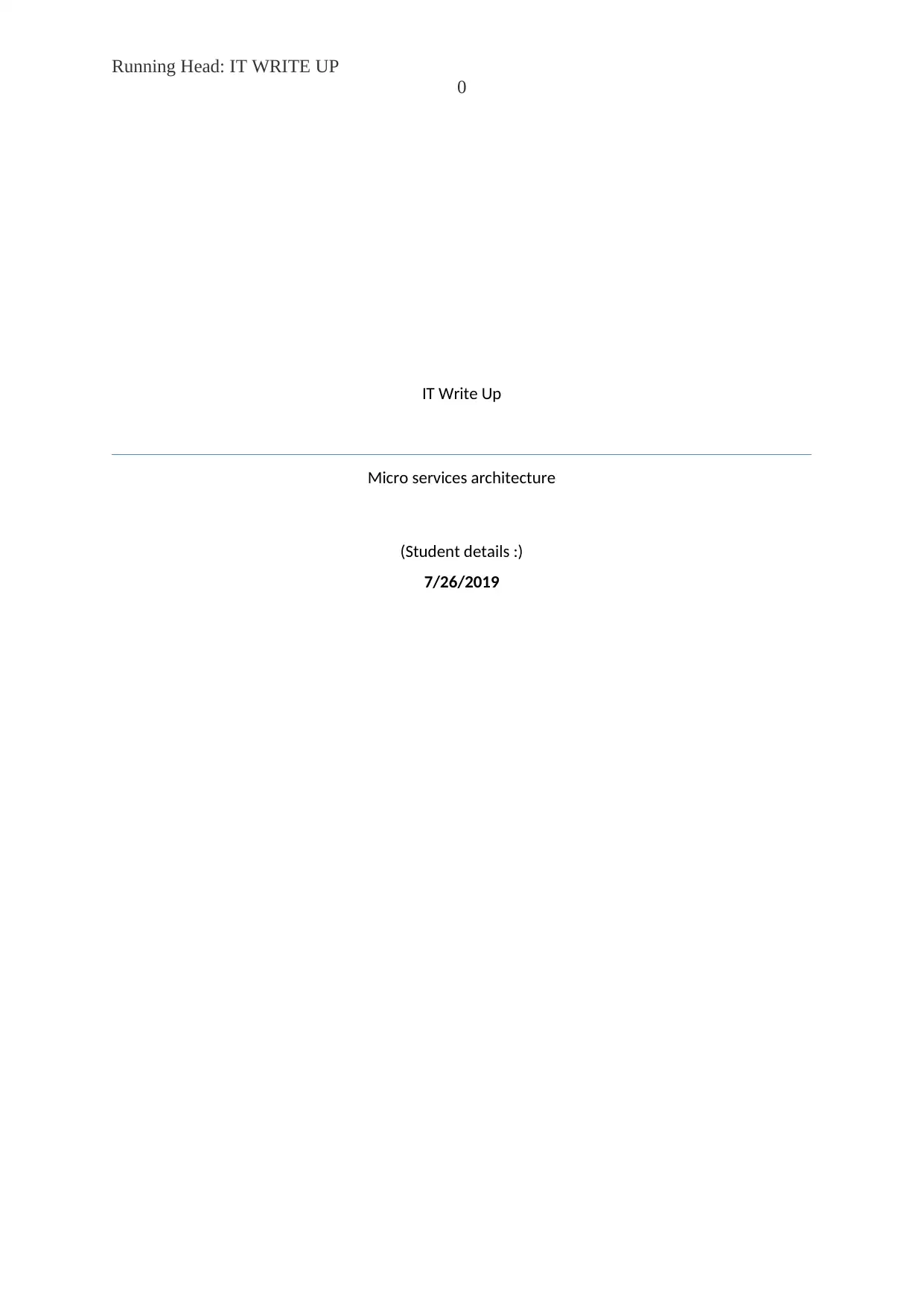
Running Head: IT WRITE UP
0
IT Write Up
Micro services architecture
(Student details :)
7/26/2019
0
IT Write Up
Micro services architecture
(Student details :)
7/26/2019
Paraphrase This Document
Need a fresh take? Get an instant paraphrase of this document with our AI Paraphraser
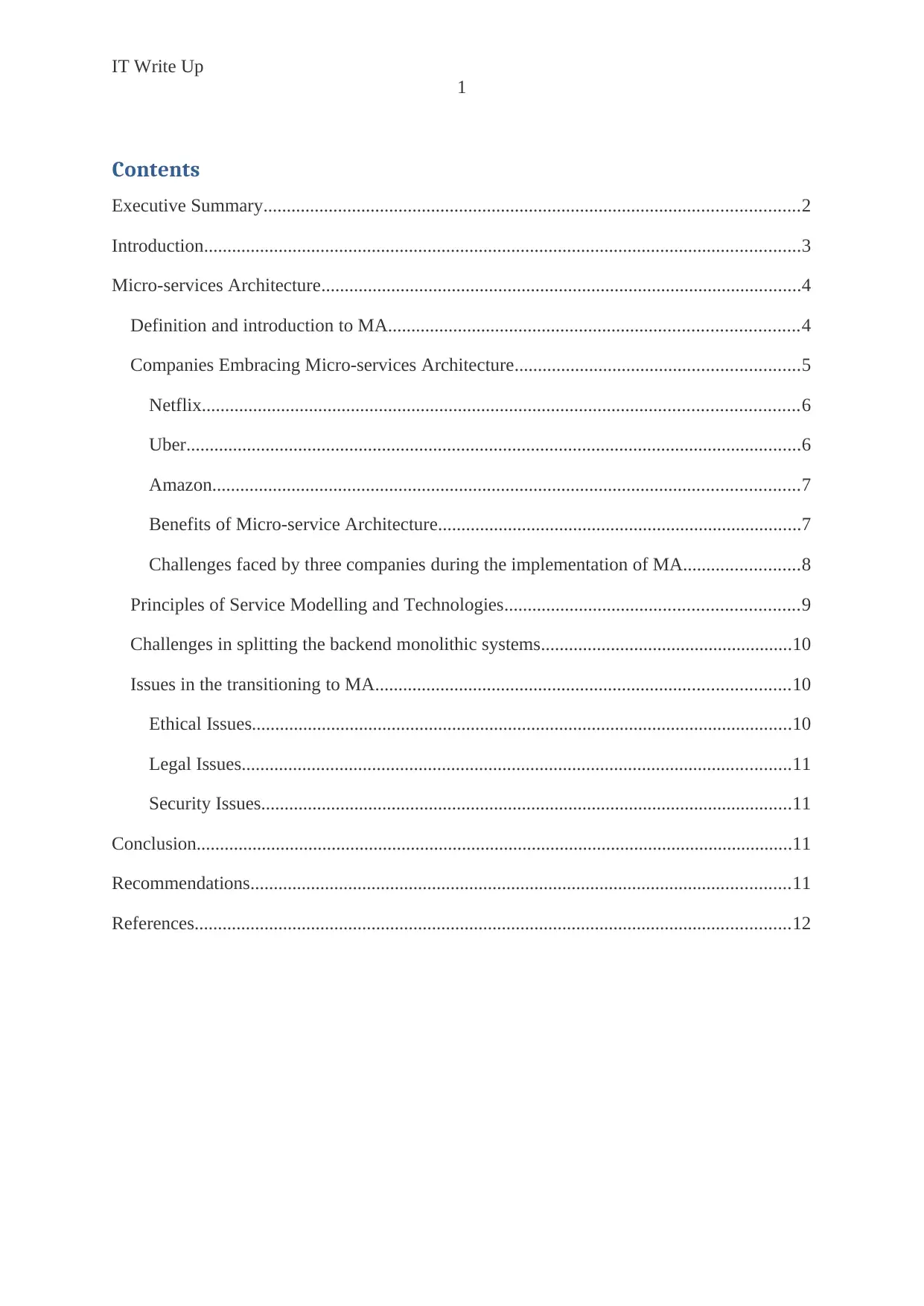
IT Write Up
1
Contents
Executive Summary...................................................................................................................2
Introduction................................................................................................................................3
Micro-services Architecture.......................................................................................................4
Definition and introduction to MA........................................................................................4
Companies Embracing Micro-services Architecture.............................................................5
Netflix................................................................................................................................6
Uber....................................................................................................................................6
Amazon..............................................................................................................................7
Benefits of Micro-service Architecture..............................................................................7
Challenges faced by three companies during the implementation of MA.........................8
Principles of Service Modelling and Technologies...............................................................9
Challenges in splitting the backend monolithic systems......................................................10
Issues in the transitioning to MA.........................................................................................10
Ethical Issues....................................................................................................................10
Legal Issues......................................................................................................................11
Security Issues..................................................................................................................11
Conclusion................................................................................................................................11
Recommendations....................................................................................................................11
References................................................................................................................................12
1
Contents
Executive Summary...................................................................................................................2
Introduction................................................................................................................................3
Micro-services Architecture.......................................................................................................4
Definition and introduction to MA........................................................................................4
Companies Embracing Micro-services Architecture.............................................................5
Netflix................................................................................................................................6
Uber....................................................................................................................................6
Amazon..............................................................................................................................7
Benefits of Micro-service Architecture..............................................................................7
Challenges faced by three companies during the implementation of MA.........................8
Principles of Service Modelling and Technologies...............................................................9
Challenges in splitting the backend monolithic systems......................................................10
Issues in the transitioning to MA.........................................................................................10
Ethical Issues....................................................................................................................10
Legal Issues......................................................................................................................11
Security Issues..................................................................................................................11
Conclusion................................................................................................................................11
Recommendations....................................................................................................................11
References................................................................................................................................12
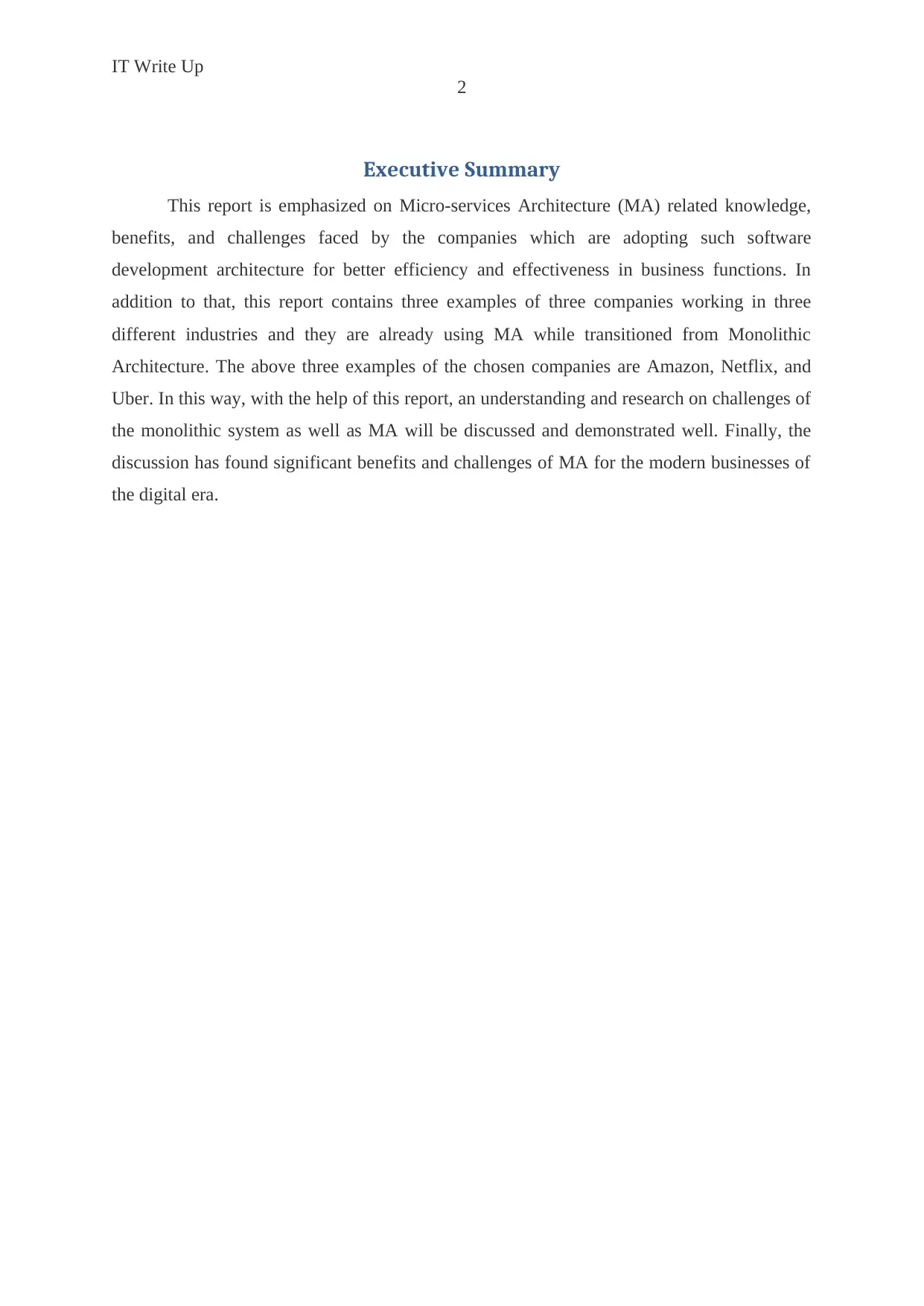
IT Write Up
2
Executive Summary
This report is emphasized on Micro-services Architecture (MA) related knowledge,
benefits, and challenges faced by the companies which are adopting such software
development architecture for better efficiency and effectiveness in business functions. In
addition to that, this report contains three examples of three companies working in three
different industries and they are already using MA while transitioned from Monolithic
Architecture. The above three examples of the chosen companies are Amazon, Netflix, and
Uber. In this way, with the help of this report, an understanding and research on challenges of
the monolithic system as well as MA will be discussed and demonstrated well. Finally, the
discussion has found significant benefits and challenges of MA for the modern businesses of
the digital era.
2
Executive Summary
This report is emphasized on Micro-services Architecture (MA) related knowledge,
benefits, and challenges faced by the companies which are adopting such software
development architecture for better efficiency and effectiveness in business functions. In
addition to that, this report contains three examples of three companies working in three
different industries and they are already using MA while transitioned from Monolithic
Architecture. The above three examples of the chosen companies are Amazon, Netflix, and
Uber. In this way, with the help of this report, an understanding and research on challenges of
the monolithic system as well as MA will be discussed and demonstrated well. Finally, the
discussion has found significant benefits and challenges of MA for the modern businesses of
the digital era.
⊘ This is a preview!⊘
Do you want full access?
Subscribe today to unlock all pages.

Trusted by 1+ million students worldwide
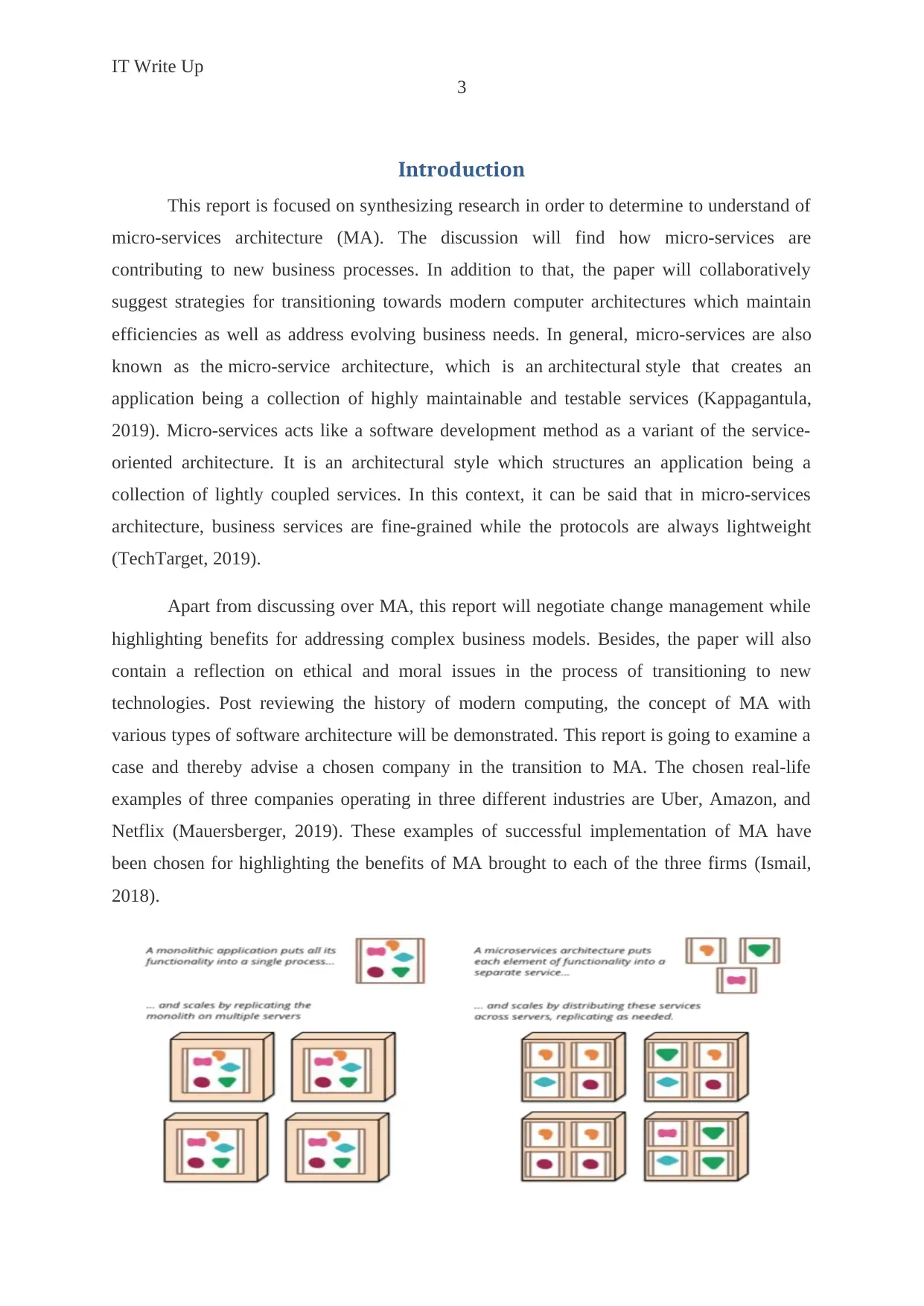
IT Write Up
3
Introduction
This report is focused on synthesizing research in order to determine to understand of
micro-services architecture (MA). The discussion will find how micro-services are
contributing to new business processes. In addition to that, the paper will collaboratively
suggest strategies for transitioning towards modern computer architectures which maintain
efficiencies as well as address evolving business needs. In general, micro-services are also
known as the micro-service architecture, which is an architectural style that creates an
application being a collection of highly maintainable and testable services (Kappagantula,
2019). Micro-services acts like a software development method as a variant of the service-
oriented architecture. It is an architectural style which structures an application being a
collection of lightly coupled services. In this context, it can be said that in micro-services
architecture, business services are fine-grained while the protocols are always lightweight
(TechTarget, 2019).
Apart from discussing over MA, this report will negotiate change management while
highlighting benefits for addressing complex business models. Besides, the paper will also
contain a reflection on ethical and moral issues in the process of transitioning to new
technologies. Post reviewing the history of modern computing, the concept of MA with
various types of software architecture will be demonstrated. This report is going to examine a
case and thereby advise a chosen company in the transition to MA. The chosen real-life
examples of three companies operating in three different industries are Uber, Amazon, and
Netflix (Mauersberger, 2019). These examples of successful implementation of MA have
been chosen for highlighting the benefits of MA brought to each of the three firms (Ismail,
2018).
3
Introduction
This report is focused on synthesizing research in order to determine to understand of
micro-services architecture (MA). The discussion will find how micro-services are
contributing to new business processes. In addition to that, the paper will collaboratively
suggest strategies for transitioning towards modern computer architectures which maintain
efficiencies as well as address evolving business needs. In general, micro-services are also
known as the micro-service architecture, which is an architectural style that creates an
application being a collection of highly maintainable and testable services (Kappagantula,
2019). Micro-services acts like a software development method as a variant of the service-
oriented architecture. It is an architectural style which structures an application being a
collection of lightly coupled services. In this context, it can be said that in micro-services
architecture, business services are fine-grained while the protocols are always lightweight
(TechTarget, 2019).
Apart from discussing over MA, this report will negotiate change management while
highlighting benefits for addressing complex business models. Besides, the paper will also
contain a reflection on ethical and moral issues in the process of transitioning to new
technologies. Post reviewing the history of modern computing, the concept of MA with
various types of software architecture will be demonstrated. This report is going to examine a
case and thereby advise a chosen company in the transition to MA. The chosen real-life
examples of three companies operating in three different industries are Uber, Amazon, and
Netflix (Mauersberger, 2019). These examples of successful implementation of MA have
been chosen for highlighting the benefits of MA brought to each of the three firms (Ismail,
2018).
Paraphrase This Document
Need a fresh take? Get an instant paraphrase of this document with our AI Paraphraser
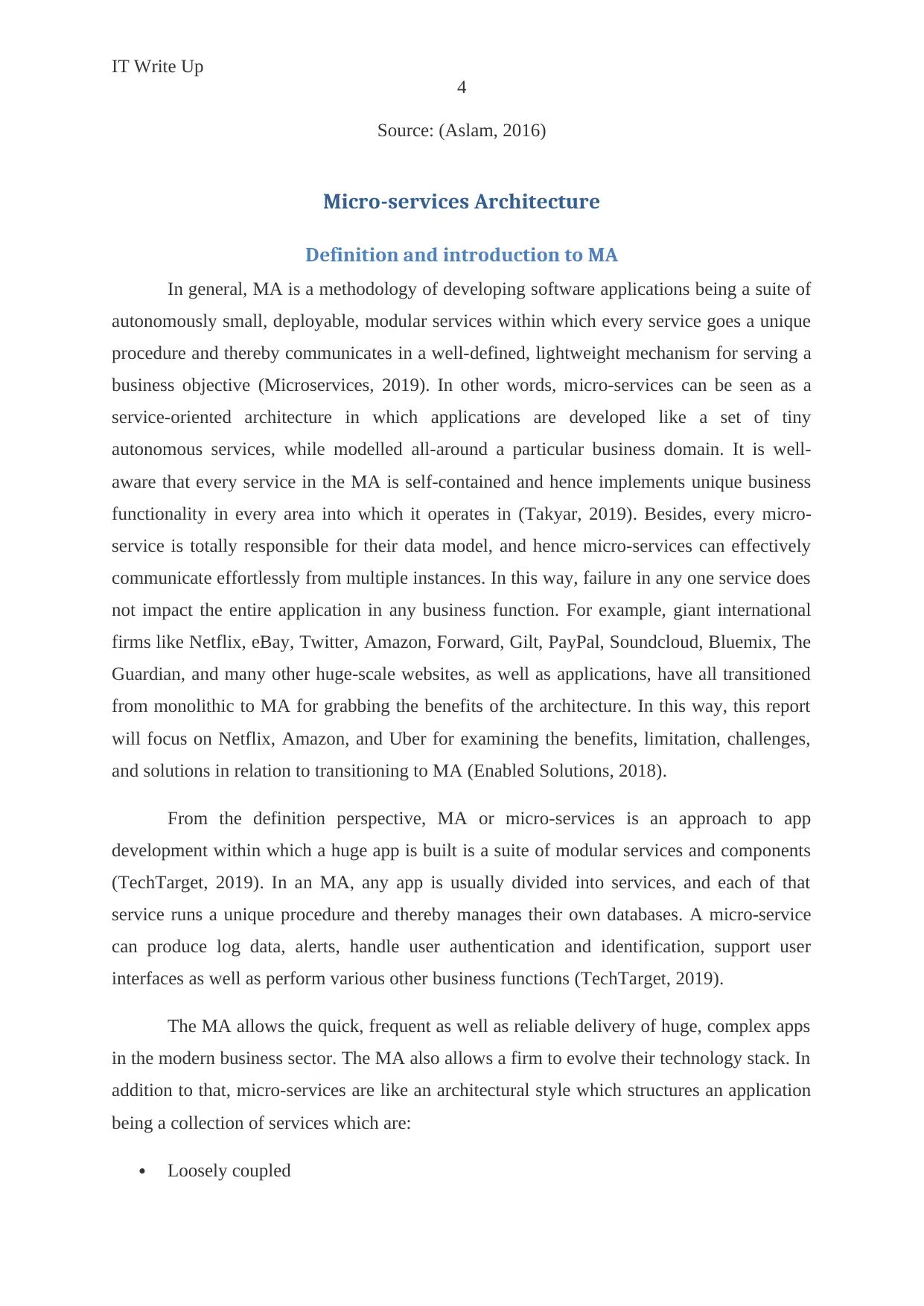
IT Write Up
4
Source: (Aslam, 2016)
Micro-services Architecture
Definition and introduction to MA
In general, MA is a methodology of developing software applications being a suite of
autonomously small, deployable, modular services within which every service goes a unique
procedure and thereby communicates in a well-defined, lightweight mechanism for serving a
business objective (Microservices, 2019). In other words, micro-services can be seen as a
service-oriented architecture in which applications are developed like a set of tiny
autonomous services, while modelled all-around a particular business domain. It is well-
aware that every service in the MA is self-contained and hence implements unique business
functionality in every area into which it operates in (Takyar, 2019). Besides, every micro-
service is totally responsible for their data model, and hence micro-services can effectively
communicate effortlessly from multiple instances. In this way, failure in any one service does
not impact the entire application in any business function. For example, giant international
firms like Netflix, eBay, Twitter, Amazon, Forward, Gilt, PayPal, Soundcloud, Bluemix, The
Guardian, and many other huge-scale websites, as well as applications, have all transitioned
from monolithic to MA for grabbing the benefits of the architecture. In this way, this report
will focus on Netflix, Amazon, and Uber for examining the benefits, limitation, challenges,
and solutions in relation to transitioning to MA (Enabled Solutions, 2018).
From the definition perspective, MA or micro-services is an approach to app
development within which a huge app is built is a suite of modular services and components
(TechTarget, 2019). In an MA, any app is usually divided into services, and each of that
service runs a unique procedure and thereby manages their own databases. A micro-service
can produce log data, alerts, handle user authentication and identification, support user
interfaces as well as perform various other business functions (TechTarget, 2019).
The MA allows the quick, frequent as well as reliable delivery of huge, complex apps
in the modern business sector. The MA also allows a firm to evolve their technology stack. In
addition to that, micro-services are like an architectural style which structures an application
being a collection of services which are:
Loosely coupled
4
Source: (Aslam, 2016)
Micro-services Architecture
Definition and introduction to MA
In general, MA is a methodology of developing software applications being a suite of
autonomously small, deployable, modular services within which every service goes a unique
procedure and thereby communicates in a well-defined, lightweight mechanism for serving a
business objective (Microservices, 2019). In other words, micro-services can be seen as a
service-oriented architecture in which applications are developed like a set of tiny
autonomous services, while modelled all-around a particular business domain. It is well-
aware that every service in the MA is self-contained and hence implements unique business
functionality in every area into which it operates in (Takyar, 2019). Besides, every micro-
service is totally responsible for their data model, and hence micro-services can effectively
communicate effortlessly from multiple instances. In this way, failure in any one service does
not impact the entire application in any business function. For example, giant international
firms like Netflix, eBay, Twitter, Amazon, Forward, Gilt, PayPal, Soundcloud, Bluemix, The
Guardian, and many other huge-scale websites, as well as applications, have all transitioned
from monolithic to MA for grabbing the benefits of the architecture. In this way, this report
will focus on Netflix, Amazon, and Uber for examining the benefits, limitation, challenges,
and solutions in relation to transitioning to MA (Enabled Solutions, 2018).
From the definition perspective, MA or micro-services is an approach to app
development within which a huge app is built is a suite of modular services and components
(TechTarget, 2019). In an MA, any app is usually divided into services, and each of that
service runs a unique procedure and thereby manages their own databases. A micro-service
can produce log data, alerts, handle user authentication and identification, support user
interfaces as well as perform various other business functions (TechTarget, 2019).
The MA allows the quick, frequent as well as reliable delivery of huge, complex apps
in the modern business sector. The MA also allows a firm to evolve their technology stack. In
addition to that, micro-services are like an architectural style which structures an application
being a collection of services which are:
Loosely coupled
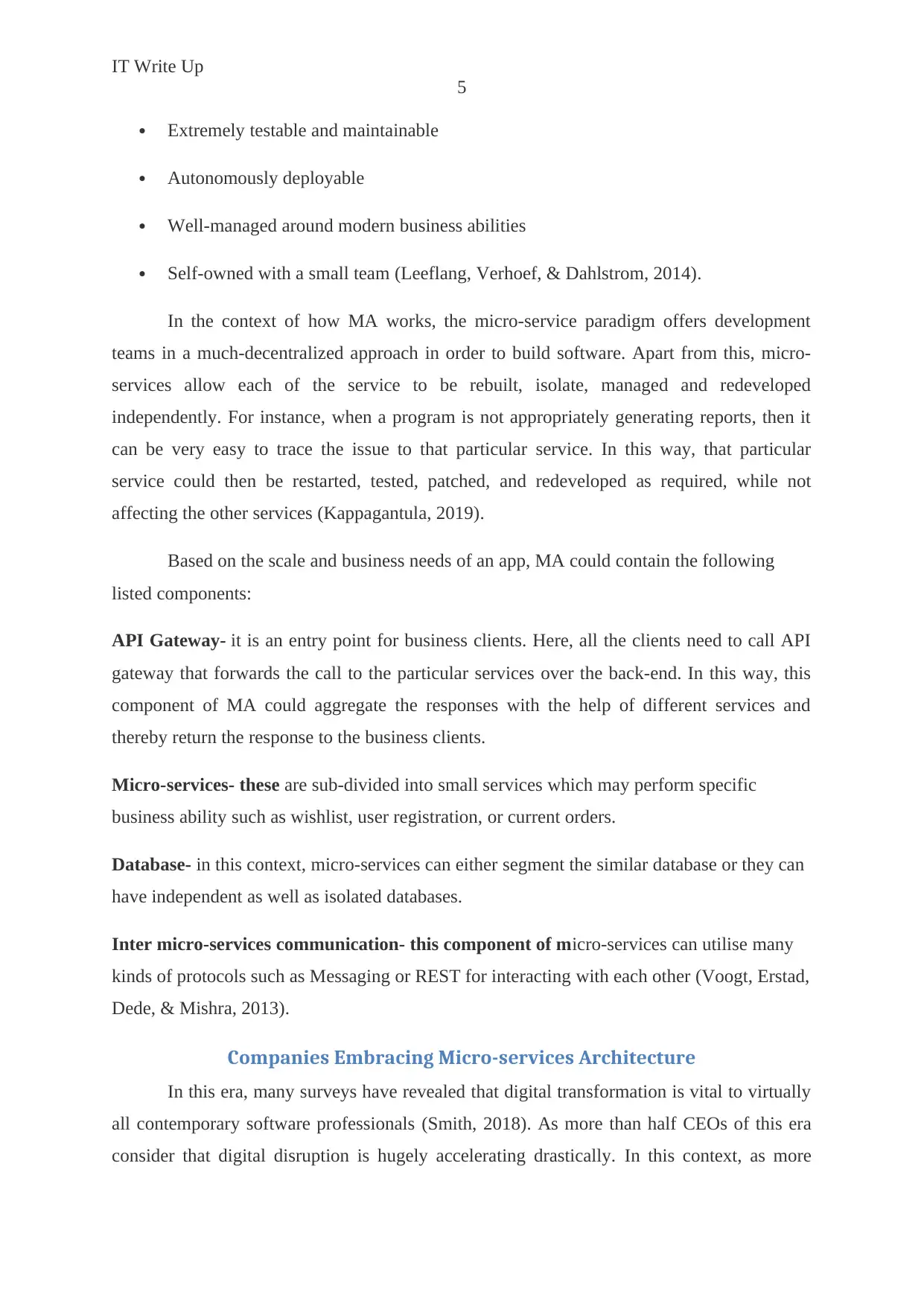
IT Write Up
5
Extremely testable and maintainable
Autonomously deployable
Well-managed around modern business abilities
Self-owned with a small team (Leeflang, Verhoef, & Dahlstrom, 2014).
In the context of how MA works, the micro-service paradigm offers development
teams in a much-decentralized approach in order to build software. Apart from this, micro-
services allow each of the service to be rebuilt, isolate, managed and redeveloped
independently. For instance, when a program is not appropriately generating reports, then it
can be very easy to trace the issue to that particular service. In this way, that particular
service could then be restarted, tested, patched, and redeveloped as required, while not
affecting the other services (Kappagantula, 2019).
Based on the scale and business needs of an app, MA could contain the following
listed components:
API Gateway- it is an entry point for business clients. Here, all the clients need to call API
gateway that forwards the call to the particular services over the back-end. In this way, this
component of MA could aggregate the responses with the help of different services and
thereby return the response to the business clients.
Micro-services- these are sub-divided into small services which may perform specific
business ability such as wishlist, user registration, or current orders.
Database- in this context, micro-services can either segment the similar database or they can
have independent as well as isolated databases.
Inter micro-services communication- this component of micro-services can utilise many
kinds of protocols such as Messaging or REST for interacting with each other (Voogt, Erstad,
Dede, & Mishra, 2013).
Companies Embracing Micro-services Architecture
In this era, many surveys have revealed that digital transformation is vital to virtually
all contemporary software professionals (Smith, 2018). As more than half CEOs of this era
consider that digital disruption is hugely accelerating drastically. In this context, as more
5
Extremely testable and maintainable
Autonomously deployable
Well-managed around modern business abilities
Self-owned with a small team (Leeflang, Verhoef, & Dahlstrom, 2014).
In the context of how MA works, the micro-service paradigm offers development
teams in a much-decentralized approach in order to build software. Apart from this, micro-
services allow each of the service to be rebuilt, isolate, managed and redeveloped
independently. For instance, when a program is not appropriately generating reports, then it
can be very easy to trace the issue to that particular service. In this way, that particular
service could then be restarted, tested, patched, and redeveloped as required, while not
affecting the other services (Kappagantula, 2019).
Based on the scale and business needs of an app, MA could contain the following
listed components:
API Gateway- it is an entry point for business clients. Here, all the clients need to call API
gateway that forwards the call to the particular services over the back-end. In this way, this
component of MA could aggregate the responses with the help of different services and
thereby return the response to the business clients.
Micro-services- these are sub-divided into small services which may perform specific
business ability such as wishlist, user registration, or current orders.
Database- in this context, micro-services can either segment the similar database or they can
have independent as well as isolated databases.
Inter micro-services communication- this component of micro-services can utilise many
kinds of protocols such as Messaging or REST for interacting with each other (Voogt, Erstad,
Dede, & Mishra, 2013).
Companies Embracing Micro-services Architecture
In this era, many surveys have revealed that digital transformation is vital to virtually
all contemporary software professionals (Smith, 2018). As more than half CEOs of this era
consider that digital disruption is hugely accelerating drastically. In this context, as more
⊘ This is a preview!⊘
Do you want full access?
Subscribe today to unlock all pages.

Trusted by 1+ million students worldwide
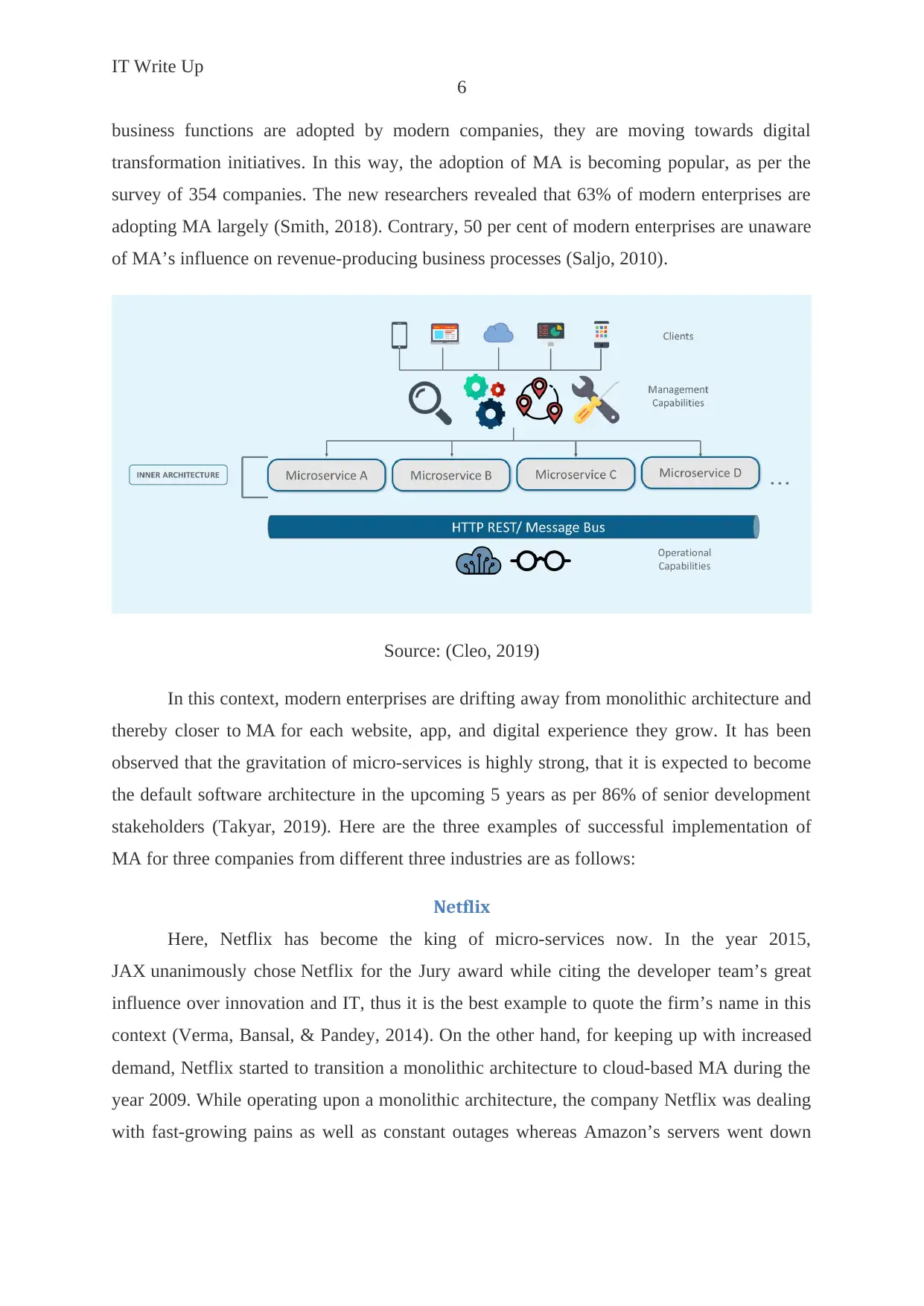
IT Write Up
6
business functions are adopted by modern companies, they are moving towards digital
transformation initiatives. In this way, the adoption of MA is becoming popular, as per the
survey of 354 companies. The new researchers revealed that 63% of modern enterprises are
adopting MA largely (Smith, 2018). Contrary, 50 per cent of modern enterprises are unaware
of MA’s influence on revenue-producing business processes (Saljo, 2010).
Source: (Cleo, 2019)
In this context, modern enterprises are drifting away from monolithic architecture and
thereby closer to MA for each website, app, and digital experience they grow. It has been
observed that the gravitation of micro-services is highly strong, that it is expected to become
the default software architecture in the upcoming 5 years as per 86% of senior development
stakeholders (Takyar, 2019). Here are the three examples of successful implementation of
MA for three companies from different three industries are as follows:
Netflix
Here, Netflix has become the king of micro-services now. In the year 2015,
JAX unanimously chose Netflix for the Jury award while citing the developer team’s great
influence over innovation and IT, thus it is the best example to quote the firm’s name in this
context (Verma, Bansal, & Pandey, 2014). On the other hand, for keeping up with increased
demand, Netflix started to transition a monolithic architecture to cloud-based MA during the
year 2009. While operating upon a monolithic architecture, the company Netflix was dealing
with fast-growing pains as well as constant outages whereas Amazon’s servers went down
6
business functions are adopted by modern companies, they are moving towards digital
transformation initiatives. In this way, the adoption of MA is becoming popular, as per the
survey of 354 companies. The new researchers revealed that 63% of modern enterprises are
adopting MA largely (Smith, 2018). Contrary, 50 per cent of modern enterprises are unaware
of MA’s influence on revenue-producing business processes (Saljo, 2010).
Source: (Cleo, 2019)
In this context, modern enterprises are drifting away from monolithic architecture and
thereby closer to MA for each website, app, and digital experience they grow. It has been
observed that the gravitation of micro-services is highly strong, that it is expected to become
the default software architecture in the upcoming 5 years as per 86% of senior development
stakeholders (Takyar, 2019). Here are the three examples of successful implementation of
MA for three companies from different three industries are as follows:
Netflix
Here, Netflix has become the king of micro-services now. In the year 2015,
JAX unanimously chose Netflix for the Jury award while citing the developer team’s great
influence over innovation and IT, thus it is the best example to quote the firm’s name in this
context (Verma, Bansal, & Pandey, 2014). On the other hand, for keeping up with increased
demand, Netflix started to transition a monolithic architecture to cloud-based MA during the
year 2009. While operating upon a monolithic architecture, the company Netflix was dealing
with fast-growing pains as well as constant outages whereas Amazon’s servers went down
Paraphrase This Document
Need a fresh take? Get an instant paraphrase of this document with our AI Paraphraser
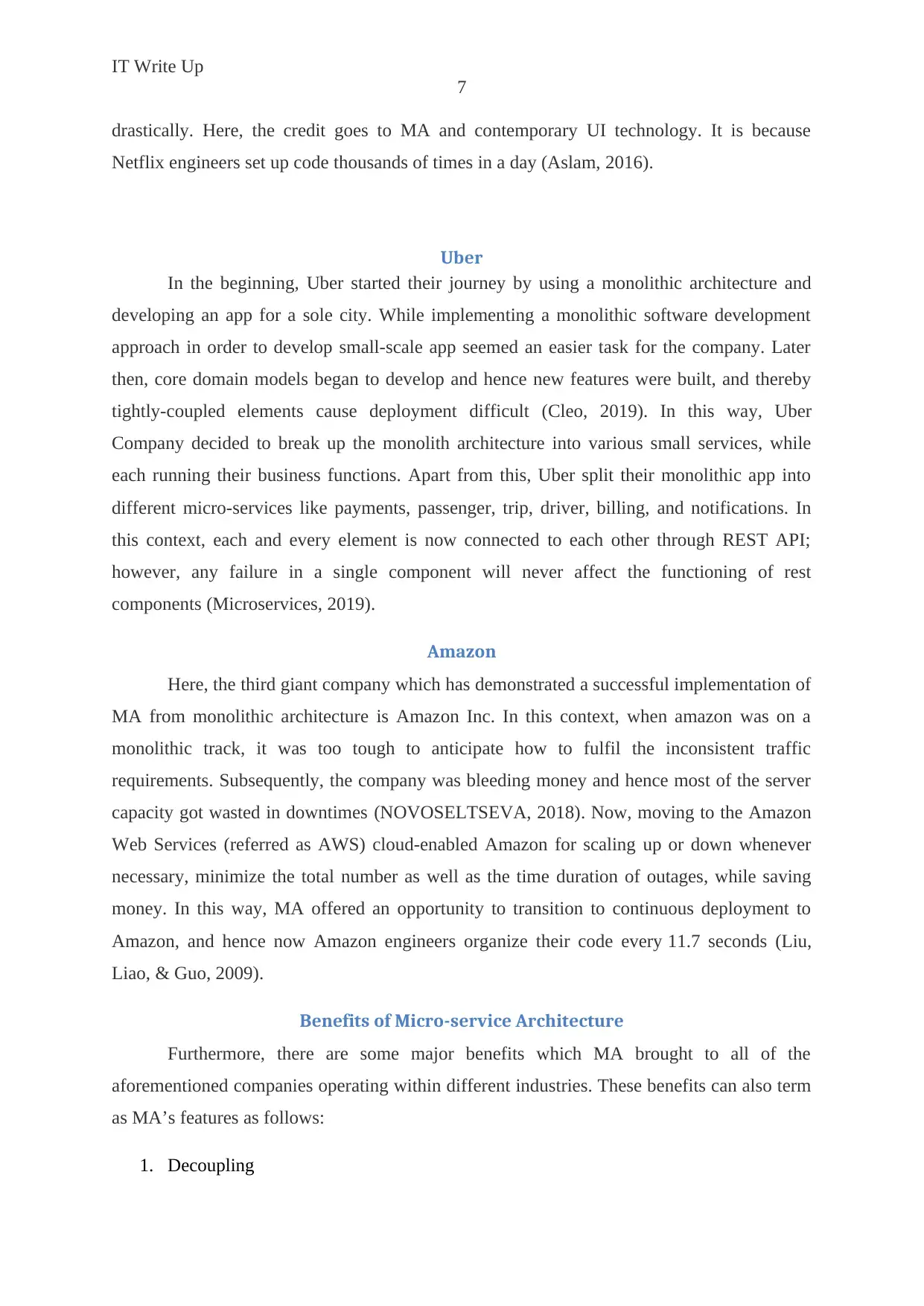
IT Write Up
7
drastically. Here, the credit goes to MA and contemporary UI technology. It is because
Netflix engineers set up code thousands of times in a day (Aslam, 2016).
Uber
In the beginning, Uber started their journey by using a monolithic architecture and
developing an app for a sole city. While implementing a monolithic software development
approach in order to develop small-scale app seemed an easier task for the company. Later
then, core domain models began to develop and hence new features were built, and thereby
tightly-coupled elements cause deployment difficult (Cleo, 2019). In this way, Uber
Company decided to break up the monolith architecture into various small services, while
each running their business functions. Apart from this, Uber split their monolithic app into
different micro-services like payments, passenger, trip, driver, billing, and notifications. In
this context, each and every element is now connected to each other through REST API;
however, any failure in a single component will never affect the functioning of rest
components (Microservices, 2019).
Amazon
Here, the third giant company which has demonstrated a successful implementation of
MA from monolithic architecture is Amazon Inc. In this context, when amazon was on a
monolithic track, it was too tough to anticipate how to fulfil the inconsistent traffic
requirements. Subsequently, the company was bleeding money and hence most of the server
capacity got wasted in downtimes (NOVOSELTSEVA, 2018). Now, moving to the Amazon
Web Services (referred as AWS) cloud-enabled Amazon for scaling up or down whenever
necessary, minimize the total number as well as the time duration of outages, while saving
money. In this way, MA offered an opportunity to transition to continuous deployment to
Amazon, and hence now Amazon engineers organize their code every 11.7 seconds (Liu,
Liao, & Guo, 2009).
Benefits of Micro-service Architecture
Furthermore, there are some major benefits which MA brought to all of the
aforementioned companies operating within different industries. These benefits can also term
as MA’s features as follows:
1. Decoupling
7
drastically. Here, the credit goes to MA and contemporary UI technology. It is because
Netflix engineers set up code thousands of times in a day (Aslam, 2016).
Uber
In the beginning, Uber started their journey by using a monolithic architecture and
developing an app for a sole city. While implementing a monolithic software development
approach in order to develop small-scale app seemed an easier task for the company. Later
then, core domain models began to develop and hence new features were built, and thereby
tightly-coupled elements cause deployment difficult (Cleo, 2019). In this way, Uber
Company decided to break up the monolith architecture into various small services, while
each running their business functions. Apart from this, Uber split their monolithic app into
different micro-services like payments, passenger, trip, driver, billing, and notifications. In
this context, each and every element is now connected to each other through REST API;
however, any failure in a single component will never affect the functioning of rest
components (Microservices, 2019).
Amazon
Here, the third giant company which has demonstrated a successful implementation of
MA from monolithic architecture is Amazon Inc. In this context, when amazon was on a
monolithic track, it was too tough to anticipate how to fulfil the inconsistent traffic
requirements. Subsequently, the company was bleeding money and hence most of the server
capacity got wasted in downtimes (NOVOSELTSEVA, 2018). Now, moving to the Amazon
Web Services (referred as AWS) cloud-enabled Amazon for scaling up or down whenever
necessary, minimize the total number as well as the time duration of outages, while saving
money. In this way, MA offered an opportunity to transition to continuous deployment to
Amazon, and hence now Amazon engineers organize their code every 11.7 seconds (Liu,
Liao, & Guo, 2009).
Benefits of Micro-service Architecture
Furthermore, there are some major benefits which MA brought to all of the
aforementioned companies operating within different industries. These benefits can also term
as MA’s features as follows:
1. Decoupling
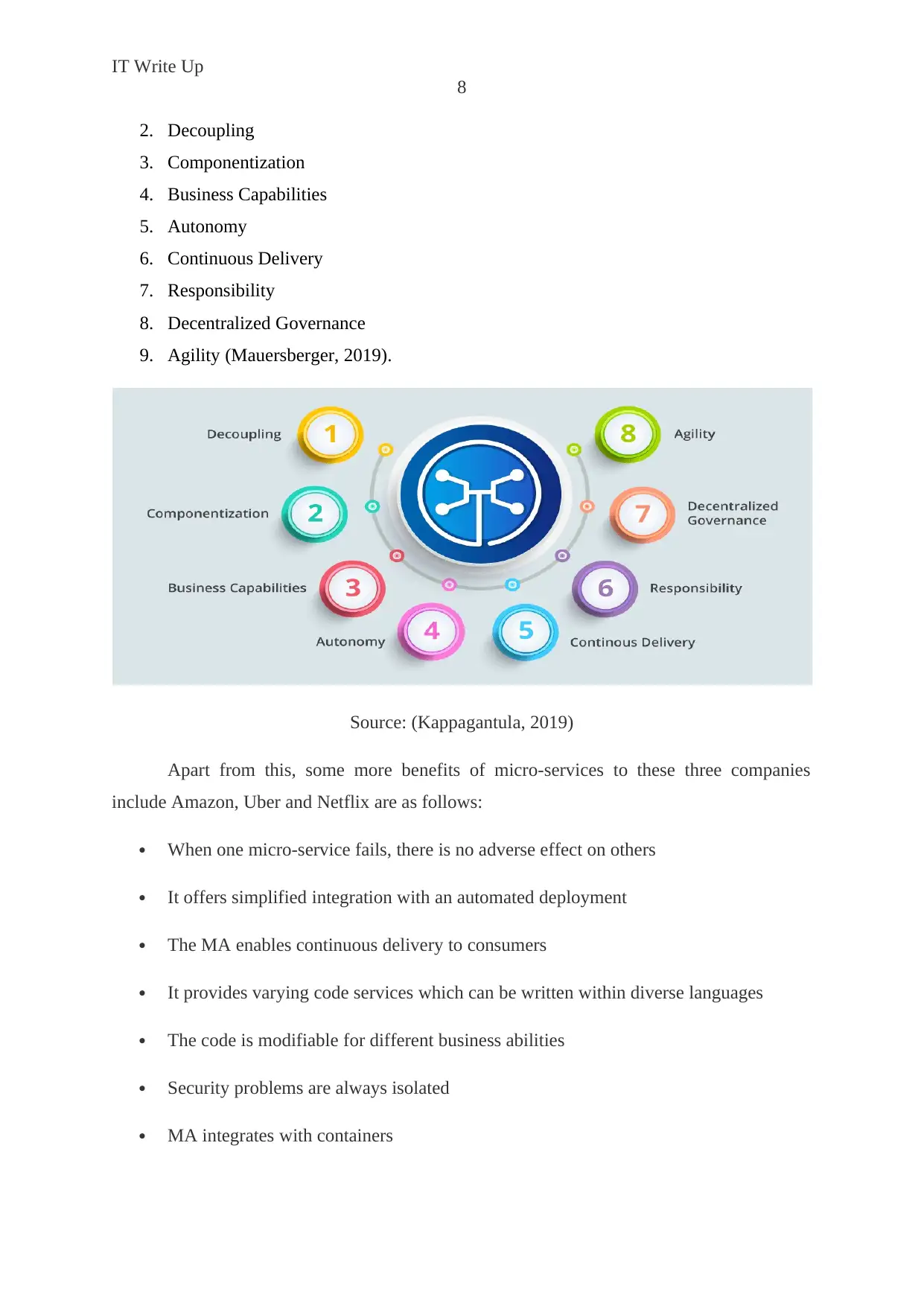
IT Write Up
8
2. Decoupling
3. Componentization
4. Business Capabilities
5. Autonomy
6. Continuous Delivery
7. Responsibility
8. Decentralized Governance
9. Agility (Mauersberger, 2019).
Source: (Kappagantula, 2019)
Apart from this, some more benefits of micro-services to these three companies
include Amazon, Uber and Netflix are as follows:
When one micro-service fails, there is no adverse effect on others
It offers simplified integration with an automated deployment
The MA enables continuous delivery to consumers
It provides varying code services which can be written within diverse languages
The code is modifiable for different business abilities
Security problems are always isolated
MA integrates with containers
8
2. Decoupling
3. Componentization
4. Business Capabilities
5. Autonomy
6. Continuous Delivery
7. Responsibility
8. Decentralized Governance
9. Agility (Mauersberger, 2019).
Source: (Kappagantula, 2019)
Apart from this, some more benefits of micro-services to these three companies
include Amazon, Uber and Netflix are as follows:
When one micro-service fails, there is no adverse effect on others
It offers simplified integration with an automated deployment
The MA enables continuous delivery to consumers
It provides varying code services which can be written within diverse languages
The code is modifiable for different business abilities
Security problems are always isolated
MA integrates with containers
⊘ This is a preview!⊘
Do you want full access?
Subscribe today to unlock all pages.

Trusted by 1+ million students worldwide
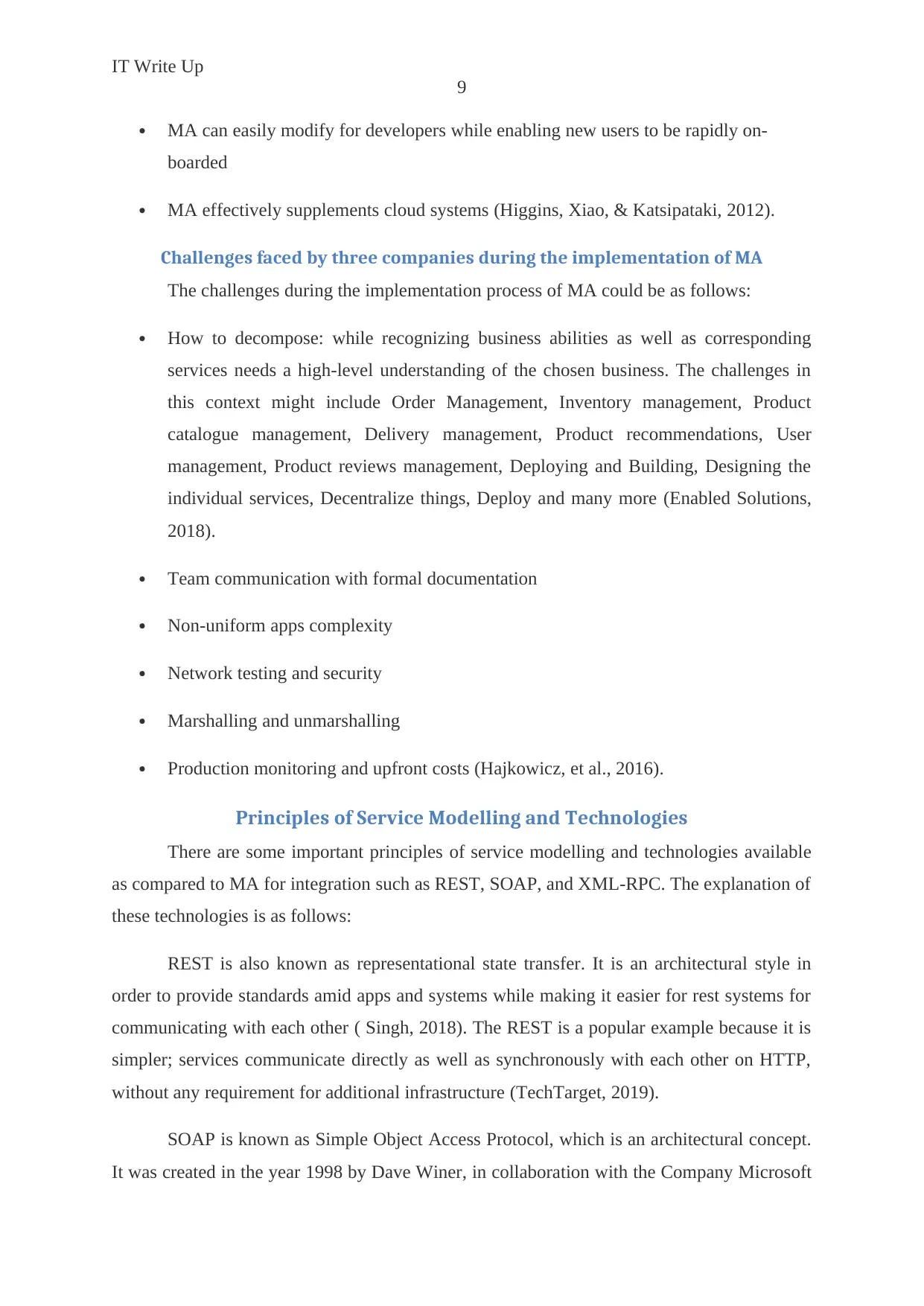
IT Write Up
9
MA can easily modify for developers while enabling new users to be rapidly on-
boarded
MA effectively supplements cloud systems (Higgins, Xiao, & Katsipataki, 2012).
Challenges faced by three companies during the implementation of MA
The challenges during the implementation process of MA could be as follows:
How to decompose: while recognizing business abilities as well as corresponding
services needs a high-level understanding of the chosen business. The challenges in
this context might include Order Management, Inventory management, Product
catalogue management, Delivery management, Product recommendations, User
management, Product reviews management, Deploying and Building, Designing the
individual services, Decentralize things, Deploy and many more (Enabled Solutions,
2018).
Team communication with formal documentation
Non-uniform apps complexity
Network testing and security
Marshalling and unmarshalling
Production monitoring and upfront costs (Hajkowicz, et al., 2016).
Principles of Service Modelling and Technologies
There are some important principles of service modelling and technologies available
as compared to MA for integration such as REST, SOAP, and XML-RPC. The explanation of
these technologies is as follows:
REST is also known as representational state transfer. It is an architectural style in
order to provide standards amid apps and systems while making it easier for rest systems for
communicating with each other ( Singh, 2018). The REST is a popular example because it is
simpler; services communicate directly as well as synchronously with each other on HTTP,
without any requirement for additional infrastructure (TechTarget, 2019).
SOAP is known as Simple Object Access Protocol, which is an architectural concept.
It was created in the year 1998 by Dave Winer, in collaboration with the Company Microsoft
9
MA can easily modify for developers while enabling new users to be rapidly on-
boarded
MA effectively supplements cloud systems (Higgins, Xiao, & Katsipataki, 2012).
Challenges faced by three companies during the implementation of MA
The challenges during the implementation process of MA could be as follows:
How to decompose: while recognizing business abilities as well as corresponding
services needs a high-level understanding of the chosen business. The challenges in
this context might include Order Management, Inventory management, Product
catalogue management, Delivery management, Product recommendations, User
management, Product reviews management, Deploying and Building, Designing the
individual services, Decentralize things, Deploy and many more (Enabled Solutions,
2018).
Team communication with formal documentation
Non-uniform apps complexity
Network testing and security
Marshalling and unmarshalling
Production monitoring and upfront costs (Hajkowicz, et al., 2016).
Principles of Service Modelling and Technologies
There are some important principles of service modelling and technologies available
as compared to MA for integration such as REST, SOAP, and XML-RPC. The explanation of
these technologies is as follows:
REST is also known as representational state transfer. It is an architectural style in
order to provide standards amid apps and systems while making it easier for rest systems for
communicating with each other ( Singh, 2018). The REST is a popular example because it is
simpler; services communicate directly as well as synchronously with each other on HTTP,
without any requirement for additional infrastructure (TechTarget, 2019).
SOAP is known as Simple Object Access Protocol, which is an architectural concept.
It was created in the year 1998 by Dave Winer, in collaboration with the Company Microsoft
Paraphrase This Document
Need a fresh take? Get an instant paraphrase of this document with our AI Paraphraser
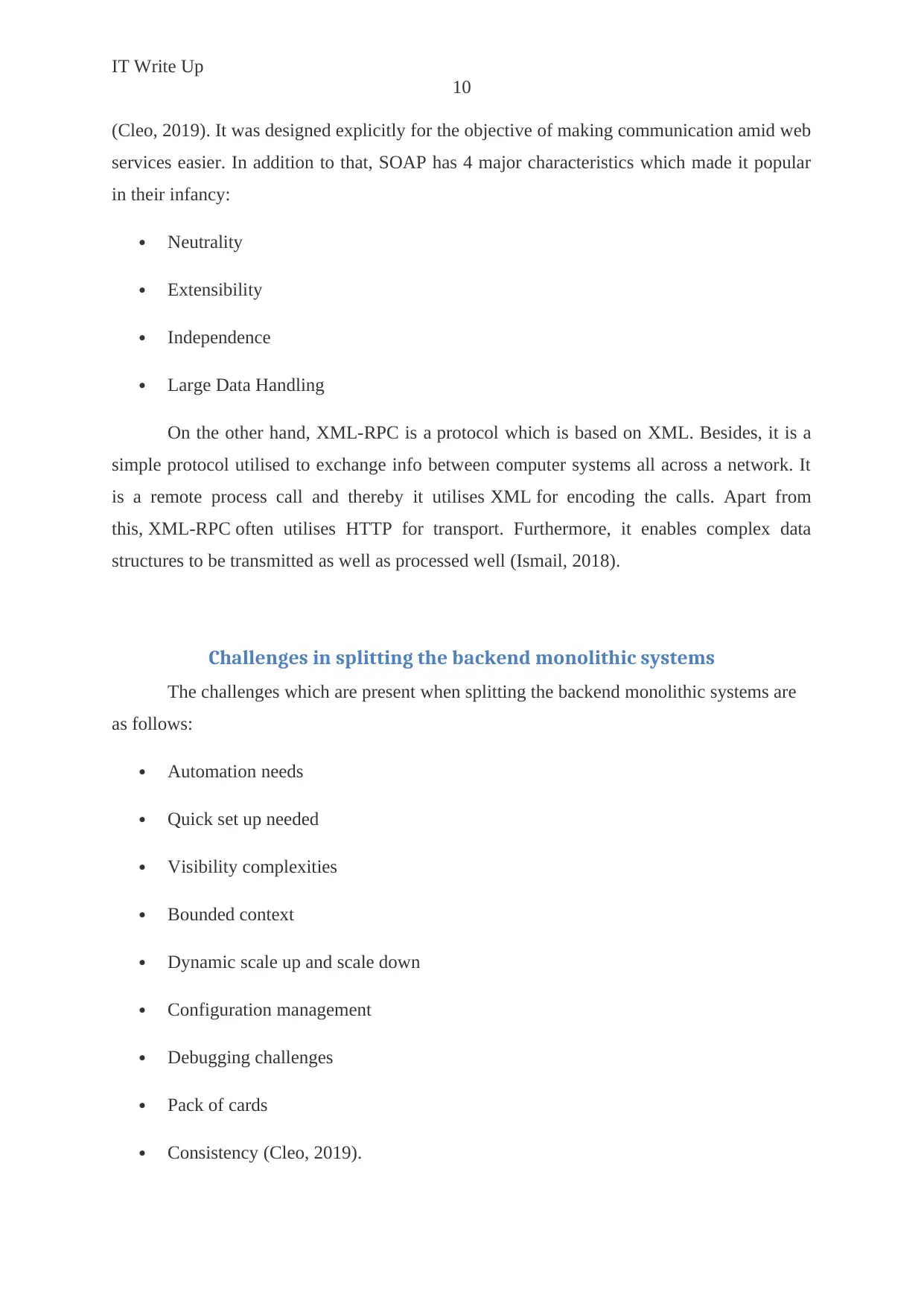
IT Write Up
10
(Cleo, 2019). It was designed explicitly for the objective of making communication amid web
services easier. In addition to that, SOAP has 4 major characteristics which made it popular
in their infancy:
Neutrality
Extensibility
Independence
Large Data Handling
On the other hand, XML-RPC is a protocol which is based on XML. Besides, it is a
simple protocol utilised to exchange info between computer systems all across a network. It
is a remote process call and thereby it utilises XML for encoding the calls. Apart from
this, XML-RPC often utilises HTTP for transport. Furthermore, it enables complex data
structures to be transmitted as well as processed well (Ismail, 2018).
Challenges in splitting the backend monolithic systems
The challenges which are present when splitting the backend monolithic systems are
as follows:
Automation needs
Quick set up needed
Visibility complexities
Bounded context
Dynamic scale up and scale down
Configuration management
Debugging challenges
Pack of cards
Consistency (Cleo, 2019).
10
(Cleo, 2019). It was designed explicitly for the objective of making communication amid web
services easier. In addition to that, SOAP has 4 major characteristics which made it popular
in their infancy:
Neutrality
Extensibility
Independence
Large Data Handling
On the other hand, XML-RPC is a protocol which is based on XML. Besides, it is a
simple protocol utilised to exchange info between computer systems all across a network. It
is a remote process call and thereby it utilises XML for encoding the calls. Apart from
this, XML-RPC often utilises HTTP for transport. Furthermore, it enables complex data
structures to be transmitted as well as processed well (Ismail, 2018).
Challenges in splitting the backend monolithic systems
The challenges which are present when splitting the backend monolithic systems are
as follows:
Automation needs
Quick set up needed
Visibility complexities
Bounded context
Dynamic scale up and scale down
Configuration management
Debugging challenges
Pack of cards
Consistency (Cleo, 2019).
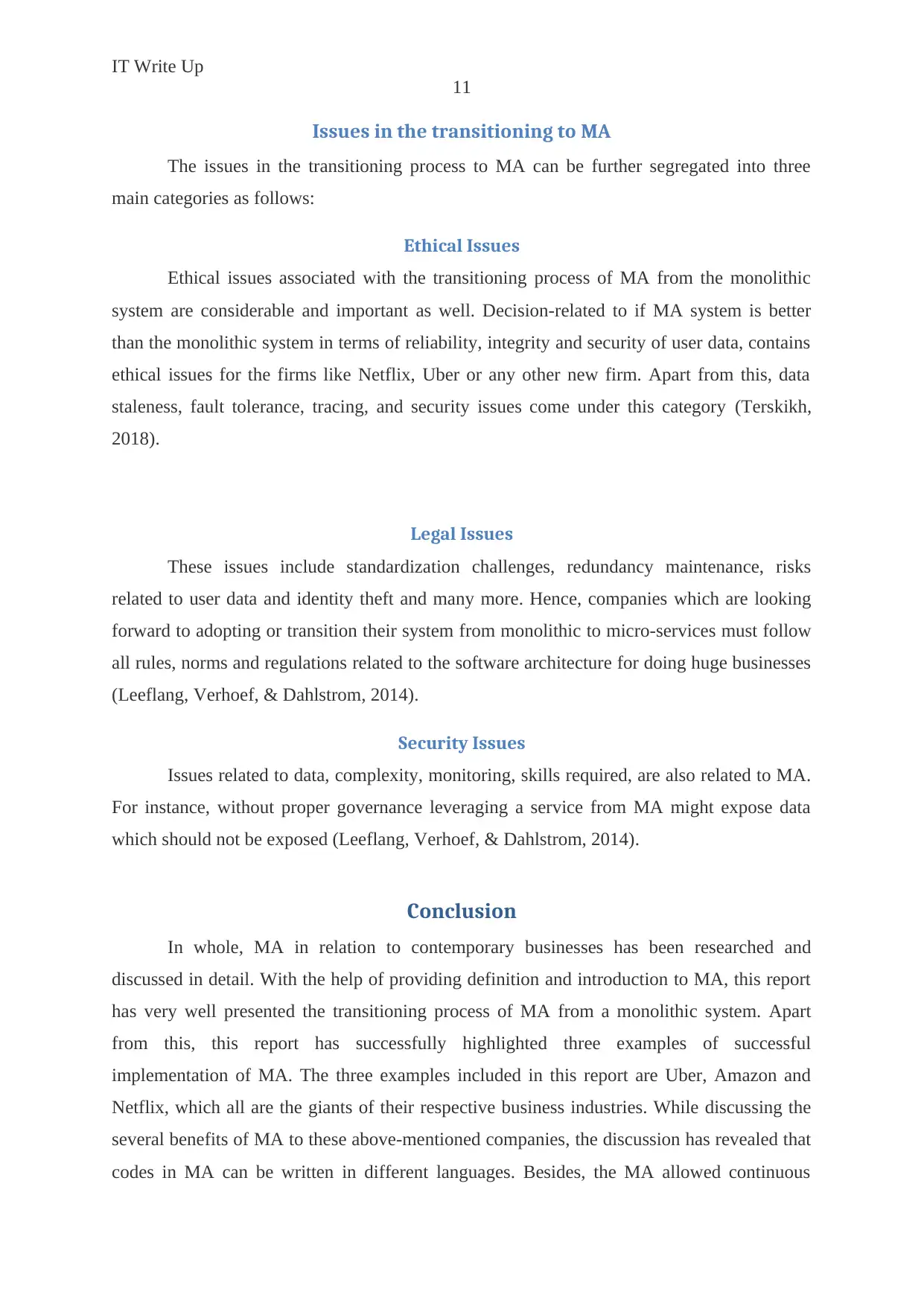
IT Write Up
11
Issues in the transitioning to MA
The issues in the transitioning process to MA can be further segregated into three
main categories as follows:
Ethical Issues
Ethical issues associated with the transitioning process of MA from the monolithic
system are considerable and important as well. Decision-related to if MA system is better
than the monolithic system in terms of reliability, integrity and security of user data, contains
ethical issues for the firms like Netflix, Uber or any other new firm. Apart from this, data
staleness, fault tolerance, tracing, and security issues come under this category (Terskikh,
2018).
Legal Issues
These issues include standardization challenges, redundancy maintenance, risks
related to user data and identity theft and many more. Hence, companies which are looking
forward to adopting or transition their system from monolithic to micro-services must follow
all rules, norms and regulations related to the software architecture for doing huge businesses
(Leeflang, Verhoef, & Dahlstrom, 2014).
Security Issues
Issues related to data, complexity, monitoring, skills required, are also related to MA.
For instance, without proper governance leveraging a service from MA might expose data
which should not be exposed (Leeflang, Verhoef, & Dahlstrom, 2014).
Conclusion
In whole, MA in relation to contemporary businesses has been researched and
discussed in detail. With the help of providing definition and introduction to MA, this report
has very well presented the transitioning process of MA from a monolithic system. Apart
from this, this report has successfully highlighted three examples of successful
implementation of MA. The three examples included in this report are Uber, Amazon and
Netflix, which all are the giants of their respective business industries. While discussing the
several benefits of MA to these above-mentioned companies, the discussion has revealed that
codes in MA can be written in different languages. Besides, the MA allowed continuous
11
Issues in the transitioning to MA
The issues in the transitioning process to MA can be further segregated into three
main categories as follows:
Ethical Issues
Ethical issues associated with the transitioning process of MA from the monolithic
system are considerable and important as well. Decision-related to if MA system is better
than the monolithic system in terms of reliability, integrity and security of user data, contains
ethical issues for the firms like Netflix, Uber or any other new firm. Apart from this, data
staleness, fault tolerance, tracing, and security issues come under this category (Terskikh,
2018).
Legal Issues
These issues include standardization challenges, redundancy maintenance, risks
related to user data and identity theft and many more. Hence, companies which are looking
forward to adopting or transition their system from monolithic to micro-services must follow
all rules, norms and regulations related to the software architecture for doing huge businesses
(Leeflang, Verhoef, & Dahlstrom, 2014).
Security Issues
Issues related to data, complexity, monitoring, skills required, are also related to MA.
For instance, without proper governance leveraging a service from MA might expose data
which should not be exposed (Leeflang, Verhoef, & Dahlstrom, 2014).
Conclusion
In whole, MA in relation to contemporary businesses has been researched and
discussed in detail. With the help of providing definition and introduction to MA, this report
has very well presented the transitioning process of MA from a monolithic system. Apart
from this, this report has successfully highlighted three examples of successful
implementation of MA. The three examples included in this report are Uber, Amazon and
Netflix, which all are the giants of their respective business industries. While discussing the
several benefits of MA to these above-mentioned companies, the discussion has revealed that
codes in MA can be written in different languages. Besides, the MA allowed continuous
⊘ This is a preview!⊘
Do you want full access?
Subscribe today to unlock all pages.

Trusted by 1+ million students worldwide
1 out of 15
Related Documents
Your All-in-One AI-Powered Toolkit for Academic Success.
+13062052269
info@desklib.com
Available 24*7 on WhatsApp / Email
![[object Object]](/_next/static/media/star-bottom.7253800d.svg)
Unlock your academic potential
Copyright © 2020–2025 A2Z Services. All Rights Reserved. Developed and managed by ZUCOL.





